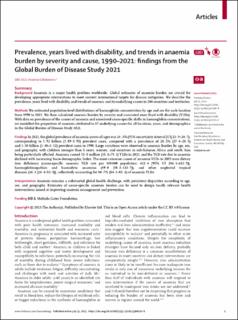| dc.contributor.author | Anaemia Collaborators, GBD 2021 | |
| dc.contributor.author | Dadras, Omid | |
| dc.contributor.author | Kisa, Sezer | |
| dc.contributor.author | Pereira, Gavin Francis | |
| dc.contributor.author | Gardner, William M. | |
| dc.contributor.author | Razo, Christian | |
| dc.contributor.author | McHugh, Theresa A | |
| dc.contributor.author | Hagins, Hailey | |
| dc.contributor.author | Vilchis-Tella, Victor M. | |
| dc.contributor.author | Hennessy, C | |
| dc.contributor.author | Taylor, Heather Jean | |
| dc.contributor.author | Perumal, Nandita | |
| dc.contributor.author | Fuller, Kia | |
| dc.contributor.author | Cercy, Kelly M. | |
| dc.contributor.author | Zoeckler, Leo | |
| dc.contributor.author | Chen, Catherine S. | |
| dc.contributor.author | Lim, Stephen S | |
| dc.contributor.author | Aali, Amirali | |
| dc.contributor.author | Abate, Kalkidan Hasen | |
| dc.contributor.author | Abd-Elsalam, Sherief | |
| dc.contributor.author | Abdurehman, Ame Mehadi | |
| dc.contributor.author | Abede, Getachew | |
| dc.contributor.author | Abidi, Hassan | |
| dc.contributor.author | Aboagye, Richard Gyan | |
| dc.contributor.author | Abolhassani, Hassan | |
| dc.contributor.author | Aboye, Girma Beressa Aboye | |
| dc.contributor.author | Abtew, Yonas Derso | |
| dc.contributor.author | Accrombessi, Manfred Mario Kokou | |
| dc.contributor.author | Adane, Denberu Eshetie Adane | |
| dc.contributor.author | Adane, Tigist Demssew | |
| dc.contributor.author | Addo, Isaac Yeboah | |
| dc.contributor.author | Adesina, Miracle Ayomikun | |
| dc.contributor.author | Adeyinka, Daniel Adedayo | |
| dc.contributor.author | Adnani, Qorinah Estiningtyas Sakilah | |
| dc.contributor.author | Afzal, Muhammad Sohail | |
| dc.contributor.author | Afzal, Saira | |
| dc.contributor.author | Agustina, Rina | |
| dc.contributor.author | Ahinkorah, Bright Opoku | |
| dc.contributor.author | Ahmad, Aqeel | |
| dc.contributor.author | Ahmad, Sajjad | |
| dc.contributor.author | Ahmadi, Sepideh | |
| dc.contributor.author | Ahmed, Ayman | |
| dc.contributor.author | Rashid, Tarik Ahmed | |
| dc.contributor.author | Aiman, Wajeeha | |
| dc.contributor.author | Ajami, Marjan | |
| dc.contributor.author | Akbarialiabad, Hossein | |
| dc.contributor.author | Alahdab, Fares | |
| dc.contributor.author | Al-Aly, Ziyad | |
| dc.contributor.author | Alam, Nazmul | |
| dc.contributor.author | Alemayehu, Astawus | |
| dc.contributor.author | Alhassan, Robert Kaba | |
| dc.date.accessioned | 2024-02-21T06:14:01Z | |
| dc.date.available | 2024-02-21T06:14:01Z | |
| dc.date.created | 2023-08-11T14:16:15Z | |
| dc.date.issued | 2023 | |
| dc.identifier.citation | The Lancet Haematology. 2023, 10 (9), e713-e734. | en_US |
| dc.identifier.issn | 2352-3026 | |
| dc.identifier.uri | https://hdl.handle.net/11250/3118810 | |
| dc.description.abstract | Background Anaemia is a major health problem worldwide. Global estimates of anaemia burden are crucial for developing appropriate interventions to meet current international targets for disease mitigation. We describe the prevalence, years lived with disability, and trends of anaemia and its underlying causes in 204 countries and territories.
Methods We estimated population-level distributions of haemoglobin concentration by age and sex for each location from 1990 to 2021. We then calculated anaemia burden by severity and associated years lived with disability (YLDs). With data on prevalence of the causes of anaemia and associated cause-specific shifts in haemoglobin concentrations, we modelled the proportion of anaemia attributed to 37 underlying causes for all locations, years, and demographics in the Global Burden of Disease Study 2021.
Findings In 2021, the global prevalence of anaemia across all ages was 24·3% (95% uncertainty interval [UI] 23·9–24·7), corresponding to 1·92 billion (1·89–1·95) prevalent cases, compared with a prevalence of 28·2% (27·8–28·5) and 1·50 billion (1·48–1·52) prevalent cases in 1990. Large variations were observed in anaemia burden by age, sex, and geography, with children younger than 5 years, women, and countries in sub-Saharan Africa and south Asia being particularly affected. Anaemia caused 52·0 million (35·1–75·1) YLDs in 2021, and the YLD rate due to anaemia declined with increasing Socio-demographic Index. The most common causes of anaemia YLDs in 2021 were dietary iron deficiency (cause-specific anaemia YLD rate per 100000 population: 422·4 [95% UI 286·1–612·9]), haemoglobinopathies and haemolytic anaemias (89·0 [58·2–123·7]), and other neglected tropical diseases (36·3 [24·4–52·8]), collectively accounting for 84·7% (84·1–85·2) of anaemia YLDs.
Interpretation Anaemia remains a substantial global health challenge, with persistent disparities according to age, sex, and geography. Estimates of cause-specific anaemia burden can be used to design locally relevant health interventions aimed at improving anaemia management and prevention. | en_US |
| dc.language.iso | eng | en_US |
| dc.rights | Navngivelse 4.0 Internasjonal | * |
| dc.rights.uri | http://creativecommons.org/licenses/by/4.0/deed.no | * |
| dc.title | Prevalence, years lived with disability, and trends in anaemia burden by severity and cause, 1990–2021: findings from the Global Burden of Disease Study 2021 | en_US |
| dc.type | Journal article | en_US |
| dc.type | Peer reviewed | en_US |
| dc.description.version | publishedVersion | en_US |
| cristin.ispublished | true | |
| cristin.fulltext | original | |
| cristin.qualitycode | 2 | |
| dc.identifier.doi | 10.1016/S2352-3026(23)00160-6 | |
| dc.identifier.cristin | 2166389 | |
| dc.source.journal | The Lancet Haematology | en_US |
| dc.source.volume | 10 | en_US |
| dc.source.issue | 9 | en_US |
| dc.source.pagenumber | e713-e734 | en_US |

